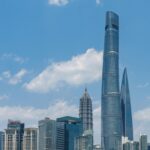Korean Economic Daily reported on the 16th that Samsung Electronics, one of the world’s largest memory chip manufacturers, plans to use its advanced process to produce next-generation high-bandwidth memory (HBM4). This type of memory is a core chip for powering artificial intelligence (AI) devices. With this move, Samsung aims to counter its competitors SK Hynix and TSMC.
Pressure from Competitors
According to the “Korea Business” website, HBM is a memory chip used in high-performance computing applications such as graphics cards, data centers, and AI. It offers higher efficiency compared to traditional memory chips. With the AI boom, the demand for HBM, which requires substantial computing power and memory bandwidth, has increased.
In April last year, Korean memory chip manufacturer SK Hynix and Taiwanese foundry TSMC signed a memorandum of understanding to jointly develop HBM4, providing relevant products to leading AI company Nvidia. This cooperation has been termed the “HBM Alliance” by many media outlets.
Currently, SK Hynix holds the top spot in the HBM market share with its HBM3 product. Industry insiders reveal that SK Hynix is accelerating the development of HBM4 and HBM4E, planning mass production in 2025 and 2026 to coincide with Nvidia’s AI accelerator launch. Benefiting from Nvidia’s rising stock price, SK Hynix, as a significant supplier, has also seen an increase in its value.
Samsung and SK Hynix have always been fierce competitors in the memory chip market. Amid the AI boom, both are striving to gain an edge through new product development and large-scale production. According to the “Korea Economic Daily,” faced with the alliance of SK Hynix and TSMC, Samsung Electronics has decided to leverage its “integrated semiconductor company” advantage to independently complete HBM production, chip design, and other tasks. The competitive landscape of the HBM4 market, with mass production starting next year, will be “Samsung Electronics vs. TSMC + SK Hynix.”
How Samsung Plans to Achieve an “HBM Reversal”
Samsung’s bet on 4nm technology is seen by the industry as an effort to reclaim lost HBM market share, with SK Hynix currently leading this market. Many in the industry initially predicted that Samsung would use 7nm or 8nm processes for HBM4 production, considering that Samsung’s 7nm process has been widely used since 2019 and is a stable process. However, Samsung’s leap to 4nm is aimed at achieving an “HBM reversal.” According to a semiconductor industry insider, “Compared to 7nm and 8nm, the 4nm process is more expensive but offers better performance and power consumption.”
TrendForce reports that Samsung’s 4nm process yield has reached over 70%, similar to TSMC’s level. Therefore, analysts suggest that if Samsung can improve its price competitiveness, it might have a chance.
“Unlike TSMC and SK Hynix, having chip designers participate in HBM4 production is our unique advantage,” stated a Samsung executive. According to the “Korea Business” website, Samsung Electronics has established a new “HBM Development Group” in its Device Solutions Division. The newly formed team will focus on advancing HBM3, HBM3E, and next-generation HBM4 technologies.
In response to Samsung’s plan, SK Hynix and TSMC are preparing countermeasures. According to the “Korean Economic Daily,” the two companies have decided to add 5nm process technology to their original 12nm process plan for producing HBM4.
“No Significant Change in Market Structure”
“The competition for AI chip supremacy between Samsung and SK Hynix is intensifying, especially in HBM4 chips. The first challenge for Samsung is to get its HBM chips approved by Nvidia,” analyzed a professional quoted by the “Korean Economic Daily.” Additionally, American memory chip company Micron is also eyeing the HBM market. A report released by Micron in June revealed its plan to increase its HBM market share from the current “mid-single digits” to about 20% within a year.
Globally, according to TrendForce, SK Hynix’s HBM market share is expected to exceed 52% in 2024, followed by Samsung at 42.4%, while Micron is expected to hold only 5%. “We believe it will take some time for Samsung to catch up due to certain technological differences,” said Fitch analyst Shelly Jiang in an interview with the “Nikkei Asian Review.” “In the medium to long term, we do not expect the market structure to undergo significant changes.”
Previously, SK Hynix issued a global recruitment advertisement to hire experienced employees for 48 HBM-related positions. The “Korean Economic Daily” reported that Samsung Electronics is on high alert for this, as it is facing a strike involving over 6,500 workers, with the semiconductor department being the main force. However, according to the “Chosun Ilbo” on the 11th, only the “National Samsung Electronics Union” among Samsung’s five unions is on strike. Due to the small number of participants, the possibility of actual chip production problems is low. However, the decline in trust may pose obstacles in attracting customers.













Its like you read my mind You appear to know a lot about this like you wrote the book in it or something I think that you could do with some pics to drive the message home a little bit but instead of that this is fantastic blog An excellent read I will certainly be back
What i do not understood is in truth how you are not actually a lot more smartlyliked than you may be now You are very intelligent You realize therefore significantly in the case of this topic produced me individually imagine it from numerous numerous angles Its like men and women dont seem to be fascinated until it is one thing to do with Woman gaga Your own stuffs nice All the time care for it up